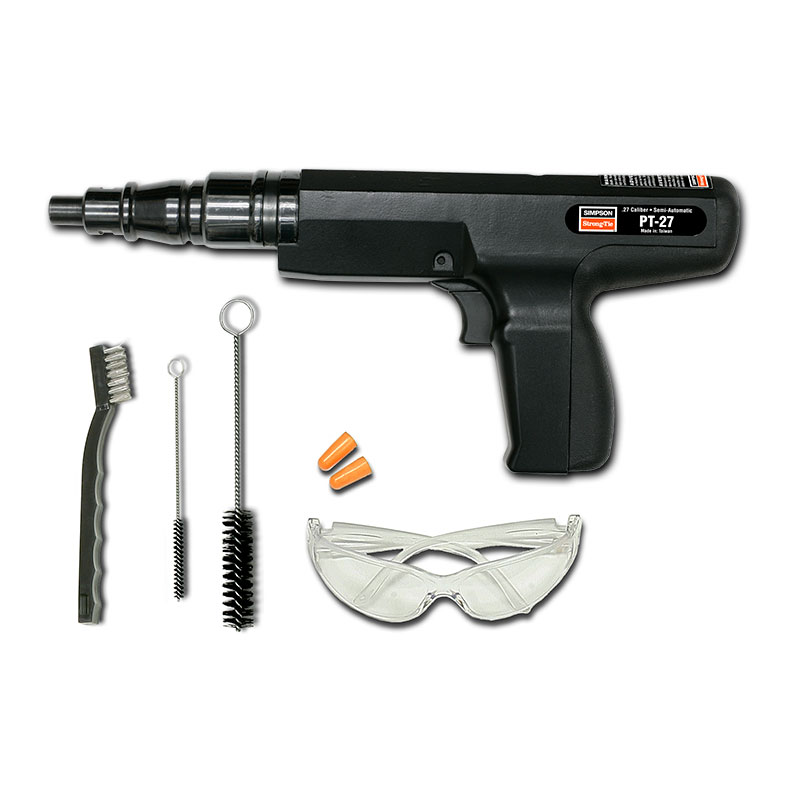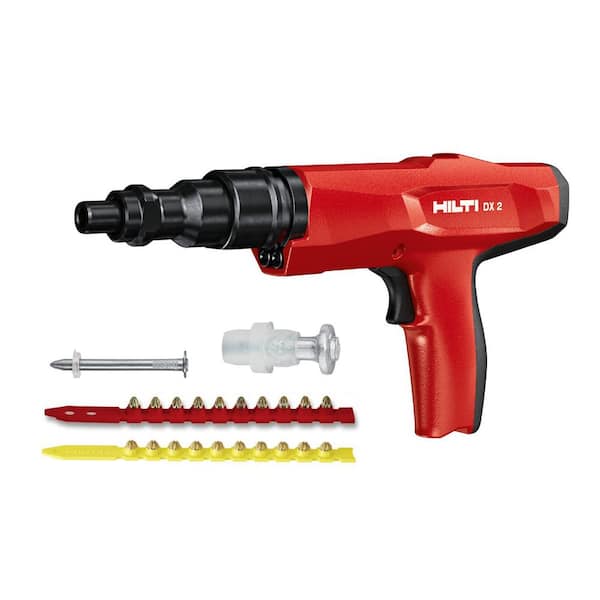Have you ever wondered how heavy-duty materials like steel or concrete get fastened so quickly on construction sites? The secret often lies in a tool that works like a powerful nail gun but packs much more punch.
That tool is called a powder actuated tool. If you’re involved in building, renovation, or even just curious about construction gear, understanding what this tool is and how it works can save you time and effort—and maybe even keep you safer.
Keep reading to discover exactly what a powder actuated tool is, how it operates, and why it might become your new best friend on the job.

Credit: en.wikipedia.org
Powder Actuated Tool Basics
Powder actuated tools are special devices used in construction and repair. They help fasten materials to hard surfaces quickly and firmly. These tools use small explosive charges to drive fasteners into concrete or steel. They are powerful and save time on tough jobs.
Understanding how these tools work and their types helps you use them safely and effectively. They have many uses in building and fixing structures. Let’s explore the basics of powder actuated tools.
How It Works
A powder actuated tool uses a small cartridge, like a bullet, to create force. When triggered, the cartridge explodes inside the tool. This explosion pushes a fastener, such as a nail or pin, into a hard surface.
The tool must be pressed firmly against the surface for safety. The explosion is controlled, so it drives the fastener without causing damage. This process is quick and strong, making it ideal for tough materials.
Types Of Tools
There are two main types of powder actuated tools: single-shot and multi-shot. Single-shot tools need a new cartridge each time. Multi-shot tools hold several cartridges for repeated use.
Tools also differ by power level and size. Light-duty tools work for small jobs. Heavy-duty tools handle large, thick materials. Choosing the right type depends on the job’s needs.
Common Applications
Powder actuated tools are popular in construction. They fasten wood, metal, and other materials to concrete or steel. Workers use them to attach electrical boxes, pipes, and framing.
They also help in fixing heavy equipment or securing wall panels. These tools speed up work and reduce the need for drilling or welding. Many builders rely on them for strong, fast fastening.
Key Components
Understanding the key components of a powder actuated tool helps to see how it works. Each part plays a vital role in driving fasteners into hard materials. The tool uses controlled explosive force to fix items securely. Here are the main parts that make this tool effective and safe to use.
Barrel And Piston
The barrel guides the fastener into the material. It holds the fastener steady during firing. Inside the barrel, the piston moves forward quickly. The piston pushes the fastener out with great force. This action drives nails or pins into concrete or steel.
Cartridges And Loads
Cartridges provide the explosive power for the tool. They contain small amounts of gunpowder or powder loads. Different load sizes control how strong the blast is. Choosing the right load prevents damage to materials. Loads come in colors to show their strength level.
Fasteners Used
Fasteners are special nails or pins made for powder tools. They have hardened tips to penetrate tough surfaces. Fasteners come in various lengths and thicknesses. Using the correct fastener ensures a solid hold. They are designed to work safely with the tool’s power.
Safety Precautions
Using a powder actuated tool can speed up many construction tasks. These tools use small explosive charges to drive fasteners into hard materials. While they are very useful, safety is very important. Following safety precautions helps prevent injuries and accidents.
Personal Protective Equipment
Always wear safety glasses to protect your eyes from flying debris. Use ear protection because these tools make loud noises. Wear gloves to protect your hands from sparks and sharp objects. Hard hats are necessary in busy work areas to guard your head.
Work Area Preparation
Clear the work area of unnecessary materials and people. Keep bystanders at a safe distance to avoid injury. Make sure the surface is stable and clean before using the tool. Avoid using the tool near flammable materials or gases.
Tool Inspection And Maintenance
Check the tool before each use for damage or wear. Clean the barrel regularly to prevent blockages. Replace worn or damaged parts immediately. Follow the manufacturer’s instructions for maintenance and storage to keep the tool safe and reliable.

Credit: strongtie.co.nz
Operating Procedures
Operating a powder actuated tool requires care and attention. Following the correct steps keeps the work safe and efficient. Understanding the operating procedures helps avoid accidents and tool damage.
Loading And Firing
Start by checking the tool is clean and free of obstructions. Insert the correct powder load into the tool chamber. Place the fastener in the muzzle or designated spot. Hold the tool firmly against the work surface. Press the trigger or activate the firing mechanism. The powder charge drives the fastener into hard materials like concrete or steel.
Proper Handling Techniques
Always wear safety goggles and ear protection. Keep fingers away from the muzzle and trigger when not firing. Hold the tool perpendicular to the surface for best results. Do not use excessive force or angle the tool. Store the tool and powder loads in a dry, secure place. Follow manufacturer instructions for maintenance and cleaning.
Troubleshooting Common Issues
If the tool misfires, check if the powder load is damaged or old. Clean the barrel and firing pin regularly to avoid jams. Ensure the fasteners are the right size and type. If the tool does not fire, inspect the trigger and firing mechanism. Replace worn parts immediately to maintain performance and safety.
Training And Certification
Training and certification are essential for safe use of powder actuated tools. These tools use explosive charges to drive fasteners. Without proper knowledge, accidents can happen easily. Learning the right handling and safety procedures protects the user and others nearby. Certification also shows that a person understands the risks and how to avoid them.
Who Should Use These Tools
Only trained workers should operate powder actuated tools. Construction workers, carpenters, and maintenance staff often use them. Beginners or untrained people must avoid these tools. Proper skills reduce the chance of injury and damage. Employers should ensure users have the right training and certification.
Training Programs Available
Many organizations offer training for powder actuated tool users. These programs cover tool operation, safety rules, and maintenance. Some classes include hands-on practice with the tools. Training can be in-person or online. Completing a program usually results in a certificate or card. This certificate proves the user knows how to work safely.
Legal And Regulatory Requirements
Several countries require certification to use powder actuated tools. Safety agencies set rules for training and use. Employers must follow these laws to avoid penalties. Proper certification may be mandatory before starting work. Regular refresher courses keep users updated on best practices. Following legal requirements helps maintain a safe workplace.

Credit: www.homedepot.com
Benefits And Limitations
Understanding the benefits and limitations of a powder actuated tool helps decide if it fits your project needs. This tool uses controlled explosive force to drive fasteners into hard materials. It offers unique advantages but also comes with risks. Knowing both sides ensures safer and smarter use.
Advantages Over Other Fastening Methods
Powder actuated tools work much faster than drills or hammers. They save time by driving nails or pins in one quick step. These tools handle tough materials like concrete and steel easily. They reduce physical effort compared to manual methods. The fastening is strong and long-lasting. They are ideal for heavy-duty construction jobs. Using them decreases noise compared to hammering. They also lower the chance of damaging surfaces around the work area.
Potential Risks And Challenges
Powder actuated tools can be dangerous if misused. The explosive charge can cause serious injury without proper training. They require safety gear like goggles and ear protection. Misfiring or ricochet is possible on hard surfaces. Not all materials suit these tools, limiting their use. Maintenance is needed to keep them working safely. They are not allowed in some job sites due to safety rules. Users must understand how to handle and store them properly.
Maintenance And Storage
Proper maintenance and storage keep your powder actuated tool safe and working well. Regular care prevents damage and ensures the tool lasts longer. Store it correctly to avoid accidents and rust. Follow simple steps to clean and store your tool effectively.
Cleaning Procedures
Clean the tool after each use. Remove dirt, dust, and powder residue. Use a soft brush or cloth to wipe parts gently. Avoid water or harsh chemicals. Light oil can protect metal parts from rust. Check the barrel and firing pin for buildup. Clean these areas carefully to keep the tool firing smoothly.
Safe Storage Practices
Store the tool in a dry, cool place. Keep it away from heat and moisture. Use the original case or a sturdy box. Lock the storage area if possible. Keep powder loads and nails separate from the tool. Make sure the tool is unloaded before storing. Proper storage reduces the risk of accidents and damage.
Longevity Tips
Inspect the tool regularly for wear and tear. Replace worn or damaged parts quickly. Avoid dropping or rough handling. Use only recommended powder loads and fasteners. Follow the manufacturer’s instructions for use and care. Regular maintenance and careful use extend the tool’s life. A well-kept tool works better and stays safe longer.
Frequently Asked Questions
What Is A Powder Actuated Tool Used For?
A powder actuated tool fastens materials to hard surfaces like concrete or steel. It uses a controlled explosive charge to drive nails or pins quickly and securely.
How Does A Powder Actuated Tool Work?
It operates by igniting a small powder charge inside the tool. This generates gas pressure that drives a fastener into tough materials efficiently and with precision.
Is A Powder Actuated Tool Safe To Use?
Yes, when used properly with safety gear and training. The tool has safety mechanisms to prevent accidental firing and should only be operated by trained personnel.
What Materials Can A Powder Actuated Tool Fasten?
It can fasten wood, metal, and other materials to concrete, brick, or steel surfaces. This versatility makes it ideal for construction and heavy-duty fastening jobs.
Conclusion
A powder actuated tool drives fasteners into hard materials quickly. It uses small explosive charges to create strong holding power. This tool saves time and effort in construction jobs. Always follow safety rules when using it to avoid injuries. Knowing how it works helps you use it right.
This tool is useful for many building tasks. Understanding its basics makes your work easier and safer.


